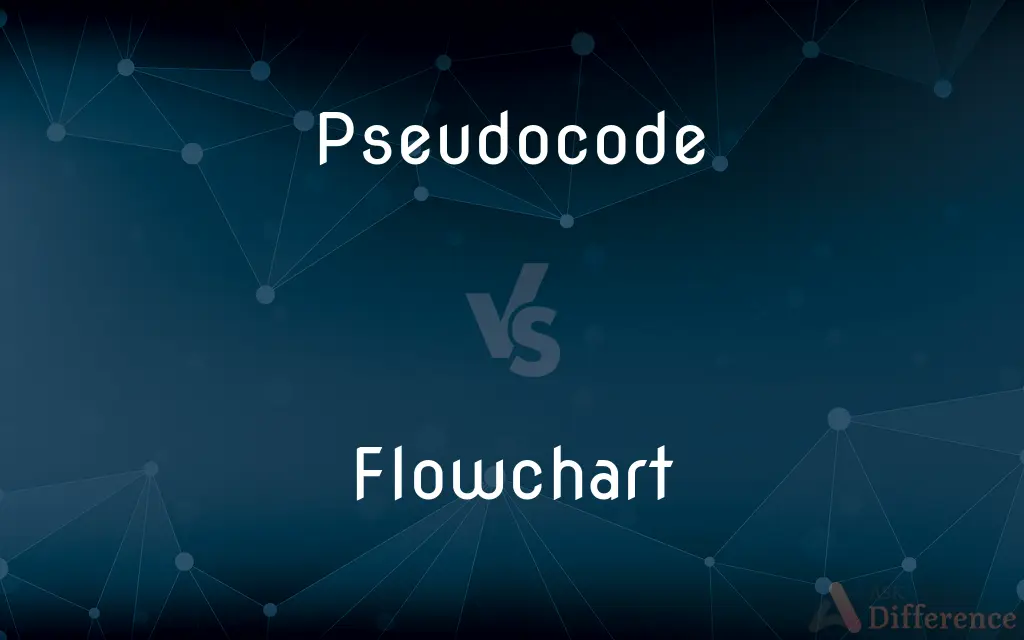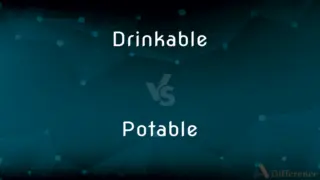Pseudocode vs. Flowchart — What's the Difference?
By Tayyaba Rehman — Updated on November 6, 2023
Pseudocode is a simplified, informal language used to describe algorithms, while a flowchart is a diagram representing the sequence of steps in an algorithm.

Difference Between Pseudocode and Flowchart
Table of Contents
ADVERTISEMENT
Key Differences
Pseudocode and Flowchart are both tools used in the planning stages of computer program development. Pseudocode is a textual representation that combines elements of programming languages with natural language to outline an algorithm. Conversely, a Flowchart is a graphical representation using symbols to illustrate the flow and sequence of a program. Each Pseudocode statement generally translates to a flowchart symbol, but while Pseudocode is written, a Flowchart is drawn.
Pseudocode emphasizes the structure and logic of an algorithm without the detail of exact syntax of programming languages, aiming to be readable by humans. Flowcharts serve a similar purpose but do so through symbols and arrows that guide the viewer through the process visually. The narrative nature of Pseudocode complements the visual layout of Flowcharts, offering two different perspectives on the same algorithmic process.
In teaching and documentation, Pseudocode is often used to communicate the essence of an algorithm without the complexity of code, allowing focus on the algorithmic concepts rather than language-specific syntax. Flowcharts offer a universal set of symbols, which can be understood across language barriers, making the sequence of operations clear through a diagram. Pseudocode and Flowcharts can be used independently but are most powerful when used together to provide both a textual and visual understanding of an algorithm.
The choice between Pseudocode and a Flowchart may depend on the complexity of the algorithm and the preference of the developer or team. Pseudocode can be more descriptive and closer to the final code, which can make the transition to coding smoother. Flowcharts might be preferred for their clarity in showing branching and looping constructs or when a visual overview of the system's flow is necessary. Each method has its strengths, with Pseudocode offering detail and narrative, and Flowcharts providing a clear, visual map of the logic.
Comparison Chart
Form
Textual representation of algorithms
Graphical representation of algorithms
ADVERTISEMENT
Focus
Logic and structure of code
Visual sequence of steps
Components
Written statements
Symbols and arrows
Usage
Describing complex logic in simple terms
Visualizing process flows and decision paths
Detail
Can be detailed and close to actual code
Provides an overview without specific details
Compare with Definitions
Pseudocode
Text-based design tool.
Pseudocode can simplify the explanation of a loop.
Flowchart
Visual algorithm mapping.
The Flowchart clarifies each step of the process.
Pseudocode
Notational system for algorithms.
Write Pseudocode for a bubble sort algorithm.
Flowchart
Symbolic procedure layout.
The Flowchart includes both processing and decision points.
Pseudocode
Informal coding script.
Her Pseudocode outlined the main function clearly.
Flowchart
Graphical problem-solving aid.
He created a Flowchart to detail the software logic.
Pseudocode
Stepwise narrative for coding.
The Pseudocode begins with input validation.
Flowchart
Organizational chart for algorithms.
A complex algorithm is often easier to understand when presented as a Flowchart.
Pseudocode
Algorithm sketch.
Pseudocode for the program was reviewed before implementation.
Flowchart
Diagrammatic process representation.
Use a Flowchart to represent the decision-making process.
Pseudocode
In computer science, pseudocode is a plain language description of the steps in an algorithm or another system. Pseudocode often uses structural conventions of a normal programming language, but is intended for human reading rather than machine reading.
Flowchart
A flowchart is a type of diagram that represents a workflow or process. A flowchart can also be defined as a diagrammatic representation of an algorithm, a step-by-step approach to solving a task.
Pseudocode
(computing) A description of a computer programming algorithm that uses the structural conventions of programming languages but omits detailed subroutines or language-specific syntax.
Flowchart
A schematic representation of a sequence of operations, as in a manufacturing process or computer program. Also called flow diagram, flow sheet.
Flowchart
Alternative spelling of flow chart
Flowchart
A diagram of the sequence of operations in a computer program or an accounting system
Common Curiosities
Are there standard symbols for Flowchart?
Yes, Flowcharts use standard symbols like ovals, rectangles, and diamonds.
Does Pseudocode have a standard syntax?
No, Pseudocode does not have a standard syntax; it is informal and flexible.
What is a Flowchart used for?
A Flowchart is used to visually represent the steps of an algorithm or process.
Is Pseudocode easier to write than actual code?
For some, yes, because it omits many of the complexities of real code.
Is a Flowchart always necessary?
No, it depends on the complexity of the algorithm and personal preference.
Can Pseudocode be converted directly into code?
Not directly; it must be translated into the syntax of a programming language.
Can a Flowchart show parallel processes?
Yes, a Flowchart can represent parallel processes using concurrent symbols.
Which is better for complex algorithms, Pseudocode or Flowchart?
Pseudocode is often better for complex logic, while Flowcharts are great for visualizing the flow.
Can Flowcharts help in debugging?
They can help visualize where a process may be failing or branching incorrectly.
Should Flowcharts be detailed?
They should be as detailed as necessary to effectively communicate the process.
What is Pseudocode used for?
Pseudocode is used to outline an algorithm in a language-agnostic way.
Is it possible to automatically generate code from Pseudocode?
Not typically, because Pseudocode is too informal and lacks precise syntax.
Can Pseudocode and Flowcharts be used together?
Yes, they complement each other well in algorithm design and analysis.
Is Pseudocode suitable for all programming languages?
Yes, because it is a generic representation of logic, not tied to any language.
Can Flowcharts be used for user interface design?
Yes, they can be used to plan the flow of user interactions.
Share Your Discovery

Previous Comparison
Wart vs. Boil
Next Comparison
Drinkable vs. PotableAuthor Spotlight
Written by
Tayyaba RehmanTayyaba Rehman is a distinguished writer, currently serving as a primary contributor to askdifference.com. As a researcher in semantics and etymology, Tayyaba's passion for the complexity of languages and their distinctions has found a perfect home on the platform. Tayyaba delves into the intricacies of language, distinguishing between commonly confused words and phrases, thereby providing clarity for readers worldwide.
















































